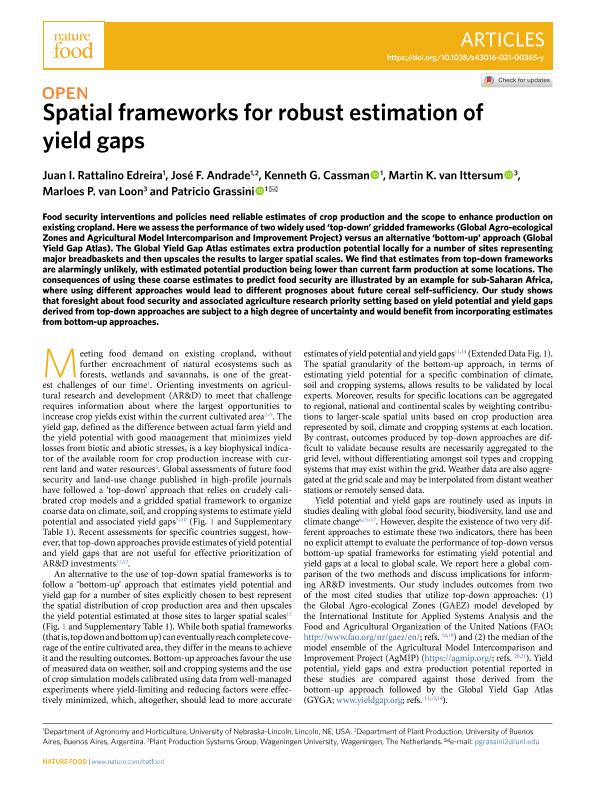Mostrar el registro sencillo del ítem
dc.contributor.author
Rattalino Edreira, Juan Ignacio

dc.contributor.author
Andrade, José Francisco

dc.contributor.author
Cassman, Kenneth G.

dc.contributor.author
van Ittersum, Martin K.
dc.contributor.author
van Loon, Marloes P.
dc.contributor.author
Grassini, Patricio

dc.date.available
2022-09-13T14:28:36Z
dc.date.issued
2021-10
dc.identifier.citation
Rattalino Edreira, Juan Ignacio; Andrade, José Francisco; Cassman, Kenneth G.; van Ittersum, Martin K.; van Loon, Marloes P.; et al.; Spatial frameworks for robust estimation of yield gaps; Springer Nature; Nature Food; 2; 10; 10-2021; 773-779
dc.identifier.uri
http://hdl.handle.net/11336/168531
dc.description.abstract
Food security interventions and policies need reliable estimates of crop production and the scope to enhance production on existing cropland. Here we assess the performance of two widely used ‘top-down’ gridded frameworks (Global Agro-ecological Zones and Agricultural Model Intercomparison and Improvement Project) versus an alternative ‘bottom-up’ approach (Global Yield Gap Atlas). The Global Yield Gap Atlas estimates extra production potential locally for a number of sites representing major breadbaskets and then upscales the results to larger spatial scales. We find that estimates from top-down frameworks are alarmingly unlikely, with estimated potential production being lower than current farm production at some locations. The consequences of using these coarse estimates to predict food security are illustrated by an example for sub-Saharan Africa, where using different approaches would lead to different prognoses about future cereal self-sufficiency. Our study shows that foresight about food security and associated agriculture research priority setting based on yield potential and yield gaps derived from top-down approaches are subject to a high degree of uncertainty and would benefit from incorporating estimates from bottom-up approaches.
dc.format
application/pdf
dc.language.iso
eng
dc.publisher
Springer Nature
dc.rights
info:eu-repo/semantics/openAccess
dc.rights.uri
https://creativecommons.org/licenses/by-nc-sa/2.5/ar/
dc.subject
NO KEYWORDS
dc.subject.classification
Agricultura

dc.subject.classification
Agricultura, Silvicultura y Pesca

dc.subject.classification
CIENCIAS AGRÍCOLAS

dc.title
Spatial frameworks for robust estimation of yield gaps
dc.type
info:eu-repo/semantics/article
dc.type
info:ar-repo/semantics/artículo
dc.type
info:eu-repo/semantics/publishedVersion
dc.date.updated
2022-08-23T20:51:06Z
dc.identifier.eissn
2662-1355
dc.journal.volume
2
dc.journal.number
10
dc.journal.pagination
773-779
dc.journal.pais
Estados Unidos

dc.description.fil
Fil: Rattalino Edreira, Juan Ignacio. Universidad de Nebraska - Lincoln; Estados Unidos. Consejo Nacional de Investigaciones Científicas y Técnicas; Argentina
dc.description.fil
Fil: Andrade, José Francisco. Universidad de Nebraska - Lincoln; Estados Unidos. Universidad de Buenos Aires. Facultad de Agronomía. Departamento de Producción Vegetal; Argentina. Consejo Nacional de Investigaciones Científicas y Técnicas; Argentina
dc.description.fil
Fil: Cassman, Kenneth G.. Universidad de Nebraska - Lincoln; Estados Unidos
dc.description.fil
Fil: van Ittersum, Martin K.. University of Agriculture Wageningen; Países Bajos
dc.description.fil
Fil: van Loon, Marloes P.. University of Agriculture Wageningen; Países Bajos
dc.description.fil
Fil: Grassini, Patricio. Universidad de Nebraska - Lincoln; Estados Unidos
dc.journal.title
Nature Food
dc.relation.alternativeid
info:eu-repo/semantics/altIdentifier/doi/http://dx.doi.org/10.1038/s43016-021-00365-y
dc.relation.alternativeid
info:eu-repo/semantics/altIdentifier/url/https://www.nature.com/articles/s43016-021-00365-y
Archivos asociados
